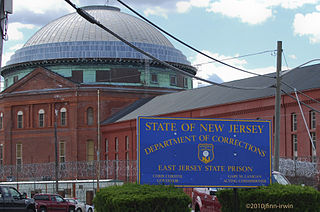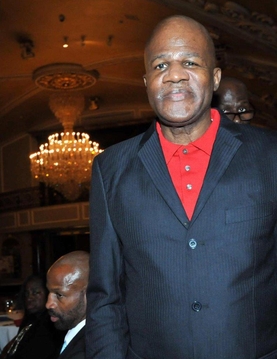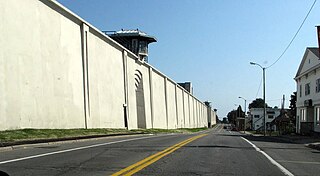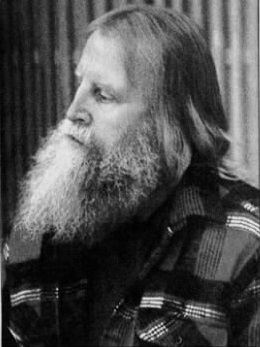Related Research Articles
Pamela Ann Smart is an American woman who was convicted of being an accomplice to first-degree murder, conspiracy to commit murder, and witness tampering in the death of her husband, Greggory Smart, in 1990. Smart, then aged 22, had conspired with her underaged boyfriend, then 15-year-old William "Billy" Flynn, and three of his friends to have Greggory (24) murdered in Derry, New Hampshire. She is currently serving a life sentence at Bedford Hills Correctional Facility for Women, a maximum security prison in Westchester County, New York.

San Quentin State Prison (SQ) is a California Department of Corrections and Rehabilitation state prison for men, located north of San Francisco in the unincorporated place of San Quentin in Marin County.

East Jersey State Prison (EJSP) is a medium-security prison operated by the New Jersey Department of Corrections in Avenel, Woodbridge Township, New Jersey. It was established in 1896 as Rahway State Prison, and was the first reformatory in New Jersey, officially opening in 1901. It housed 1,227 inmates as of 2020.

Oregon State Penitentiary (OSP), sometimes called Oregon State Prison, is a maximum security prison in the northwest United States in Salem, Oregon. Originally opened in Portland 172 years ago in 1851, it relocated to Salem fifteen years later. The 2,242-capacity prison is the oldest in the state; the all-male facility is operated by the Oregon Department of Corrections (ODOC). OSP contains an intensive management wing, which is being transformed into a psychiatric facility for mentally ill prisoners throughout Oregon.

The United States Penitentiary, Coleman I and II are high-security United States federal prisons for male inmates in Florida. It is part of the Coleman Federal Correctional Complex and is operated by the Federal Bureau of Prisons, a division of the United States Department of Justice. USP Coleman I was opened in 2001, and in 2004 Clark Construction completed a 555,000-square-foot (51,600 m2) additional component for USP Coleman II.
The Parole Board of Canada is the Canadian government agency that is responsible for reviewing and issuing parole and criminal pardons in Canada. It operates under the auspices of Public Safety Canada.
Edna Mahan Correctional Facility for Women is a prison facility for women of the state of New Jersey Department of Corrections, located in Union Township, Hunterdon County, New Jersey, near Clinton. Its official abbreviation is EMCFW. The facility was named for Edna Mahan, one of the first female correctional superintendents in the U.S.

Robert Oakley Marshall was an American businessman who in 1984 was charged with the contract killing of his wife Maria.

HM Prison Full Sutton is a Category A and B men's prison in the village of Full Sutton, near Pocklington in the East Riding of Yorkshire, England. Full Sutton is operated by His Majesty's Prison Service, and held some 596 inmates, as of September 2018. The prison's primary function is to hold, in conditions of high security, some of the most difficult and dangerous criminals in the country.

James Onque Scott Jr. was an American boxer and convicted murderer. He became the number 2 ranked contender in the World Boxing Association's (WBA) light heavyweight division while incarcerated at Rahway State Prison in Avenel, New Jersey. Scott fought a total of 22 professional fights. 11 of those fights were contested while he was in prison, and Scott earned pay and WBA rankings from many of those fights, which was considered controversial.
Theodore Walter Trautwein was an American judge from New Jersey who presided over issues related to release of reporter's notes that arose from the 1978 murder trial of "Dr. X" physician Mario Jascalevich, in which Trautwein held a reporter from The New York Times in contempt for refusing to turn over these investigative notes and held the reporter involved in jail for 40 days, triggering a separate set of cases on the limits of shield laws in protecting journalists from testifying about information they collected from their sources.
Frederick C. Galda was an American attorney and Democratic Party politician from New Jersey who served as a prosecutor in the Thomas Trantino murder case, as a judge on the New Jersey Superior Court who issued the state's first ruling acquitting a woman of murder based on a battered woman defense and served as Mayor of Paramus, New Jersey.
Guy W. Calissi, was an American Democratic Party politician, prosecutor, lawyer and judge, who served for seven years as Mayor of Wood-Ridge, New Jersey, 16 years as Bergen County, New Jersey prosecutor and was appointed in 1970 to serve as a judge on New Jersey Superior Court, a post he served in until his mandatory retirement at age 70 in the year before his death.
Marsy's Law, the California Victims' Bill of Rights Act of 2008, enacted by voters as Proposition 9 through the initiative process in the November 2008 general election, is a controversial amendment to the state's constitution and certain penal code sections. The act protects and expands the legal rights of victims of crime to include 17 rights in the judicial process, including the right to legal standing, protection from the defendant, notification of all court proceedings, and restitution, as well as granting parole boards far greater powers to deny inmates parole. Critics allege that the law unconstitutionally restricts defendant's rights by allowing prosecutors to withhold exculpatory evidence under certain circumstances, and harms victims by restricting their rights to discovery, depositions, and interviews. Passage of this law in California led to the passage of similar laws in Florida, Georgia, Illinois, Kentucky, Nevada, North Carolina, Oklahoma, Ohio and Wisconsin, and efforts to pass similar laws in Hawaii, Iowa, Montana, Idaho, South Dakota, and Pennsylvania. In November 2017, Marsy's Law was found to be unconstitutional and void in its entirety by the Supreme Court of Montana for violating that state's procedure for amending the Montana Constitution. The Pennsylvania Supreme Court reached the same conclusion as Montana under its own state constitution in 2021.
The New Zealand Parole Board is an independent statutory body established in 2002 that considers offenders for parole. Its task "is to undertake an assessment of the risk that long-term sentenced offenders might pose to the safety of the community if they were to be released before the end of their sentence". The Board also sets conditions of release for offenders so their reintegration back in to the community can be effectively managed. Once the conditions are set it becomes the responsibility of Community Corrections to manage the offender." 'Long term' is defined as more than 24 months. Short-term prisoners are automatically released after serving half their sentence.

The 2015 Clinton Correctional Facility escape was a jailbreak that took place on June 6, 2015, when two inmates, Richard Matt and David Sweat, were discovered missing during a 5:17 a.m. bed check at the maximum security Clinton Correctional Facility in Dannemora, New York, United States. Matt was serving 25 years to life and Sweat was serving life without parole, both for murder. The two prisoners had escaped by cutting a hole in their cell walls gaining access to the utility areas behind and above their cells. Eventually they cut a hole in a steam pipe and used the pipe to escape from the prison into the city sewer, with tools obtained from two cooperating prison employees. Nearly three weeks after the escape, Matt was found in Malone, New York, where he was shot and killed; two days after that, Sweat was shot and taken into custody. The manhunt and investigation were said to have cost about $23 million.
Gregory Ulas "Greg" Powell was an American criminal who kidnapped Los Angeles Police Department Officers Ian Campbell and Karl Hettinger on the night of March 9, 1963. Assisted by accomplice Jimmy Lee "Youngblood" Smith, Powell took the officers to an onion field near Bakersfield, California, where Officer Campbell was fatally shot.
James Jerold Koedatich is an American serial killer who was sentenced to death for the killings of two women in Morris County, New Jersey, which he committed during the final months of 1982, after having been previously paroled for the 1971 murder of his roommate in Florida. Koedatich had killed a fellow inmate in 1973, but that was ruled to be self-defense.

Robert Ronald "Mudman" Simon, also known as Bobby Simon, was an American outlaw biker, convicted murderer and member of the Pennsylvania-based Warlocks Motorcycle Club. He had formerly been sentenced to death by the state of New Jersey on May 6, 1995, for his part in the fatal shooting of Franklin Township police sergeant Ippolito Gonzalez. However, he was ultimately beaten to death at New Jersey State Prison by a fellow death row inmate before he could be executed.
References
- 1 2 3 Ferretti, Fred. "An Inmate at Rahway Writes and Illustrates Two Books; He Turns to Art He Talk of His Life", The New York Times , March 4, 1973. Accessed October 15, 2009.
- ↑ Voto / Tedesco Memorial, Lodi, New Jersey Police Department. Accessed October 15, 2009.
- 1 2 Slocum, John W. "1,000 POLICE JOIN IN LODI FUNERAL; Victims of Gunmen Buried as Town Mourns Citations Ordered Second Funeral Held Emotions Summed Up Trantino Arraigned 'I Held My Breath'", The New York Times , August 30, 1963. Accessed October 15, 2009.
- ↑ Staff. "Trantino Sent to Jersey in Irons", The New York Times , September 26, 1963. Accessed October 16, 2009.
- ↑ Slocum, John W. "Trantino Convicted in Slaying Of Two Policemen in Lodi, N.J.", The New York Times , February 19, 1964. Accessed July 28, 2016.
- ↑ Staff. "TRANTINO GETS CHAIR FOR POLICE KILLINGS", The New York Times , February 29, 1964. Accessed July 28, 2016.
- ↑ Treaster, Joseph B. "5 Rahway Prison Leaders Moved After Big Meeting", The New York Times , May 2, 1974. Accessed October 15, 2009.
- ↑ Hanley, Robert. "500 Protest Parole of Killer of Two Officers; Sentence Was Commuted to Life Intent of Law Is Explained 500 in Bergen Protest Parole of the Murderer Of Two Police Officers", The New York Times , September 1980. Accessed October 15, 2009.
- ↑ Hanley, Robert. "Judge in Jersey Declines to Put Price on 2 Lives; So Restitution Move Fails in Murder Parole Case An 'Impossible' Task Background of the Case Police Demonstration Recalled Judge Declines to Set A Price for Restitution In Murder Parole Case Application to Murder", The New York Times , October 3, 1980. Accessed October 12, 2009.
- ↑ Corcoran, David. "Theodore Trautwein, Judge in Landmark Press Case, Dies at 80", The New York Times , September 2, 2000. Accessed October 13, 2009.
- ↑ Hanley, Robert. "RESTITUTION PLAN IN MURDER CASES UPHELD IN JERSEY", The New York Times , May 21, 1982. Accessed October 16, 2009.
- ↑ via Associated Press . "THE REGION; Trantino Parole Formally Denied", The New York Times , November 23, 1982. Accessed October 16, 2009.
- ↑ via Associated Press . "METRO DATELINE; Killer of 2 Policemen Wins Parole in Jersey", The New York Times , January 30, 1988. Accessed October 16, 2009.
- ↑ via Associated Press . "2,000 Protest Man's Parole", The New York Times , February 6, 1988. Accessed October 16, 2009.
- ↑ Staff. "Metro Datelines; Jersey Denies Parole In '64 Police Killings", The New York Times , March 3, 1988. Accessed October 16, 2009.
- ↑ via Associated Press , "Metro Datelines; Killer of 2 Officers Denied Parole Again", The New York Times , November 23, 1990. Accessed October 16, 2009.
- ↑ Staff. "METRO NEWS BRIEFS: NEW JERSEY; Halfway-House Request By Killer of 2 Is Rejected", The New York Times , November 13, 1998. Accessed October 16, 2009.
- ↑ Hanley, Robert. "Killer of New Jersey Officers Faces at Least 4½ More Years", The New York Times , November 11, 1999. Accessed October 16, 2009.
- ↑ Hanley, Robert. "Court Orders Parole for Officers' Killer, Held for 36 Years", The New York Times , June 10, 2000. Accessed October 16, 2009.
- ↑ Peterson, Iver. "New Jersey Court Orders Parole for Man Who Killed Two Officers in 1963", The New York Times , January 19, 2001. Accessed October 16, 2009.
- ↑ Newman, Maria. "Paroled Police Killer Will Face Restrictions", The New York Times , January 20, 2001. Accessed October 16, 2009.
- ↑ Staff. "Police Killer Is Transferred To Camden", The New York Times , February 13, 2001. Accessed October 16, 2009.
- ↑ Staff. "Metro Briefing | New Jersey: Camden: Police Killer Released", The New York Times , February 12, 2002. Accessed October 17, 2009.
- ↑ Jacobs, Andrew. "Freed After 38 Years, a Killer Struggles to Fit In", The New York Times , February 27, 2002. Accessed October 14, 2009. "But living in obscurity will be a challenge for Mr. Trantino, 64, who was the state's longest-serving inmate, but was given his liberty only after the New Jersey Supreme Court intervened on his behalf."